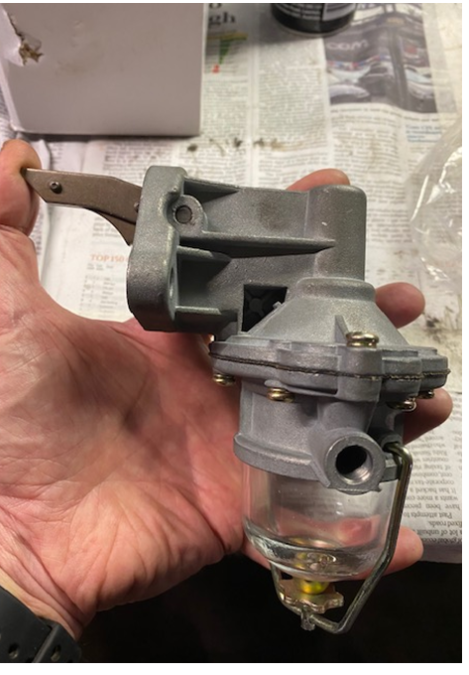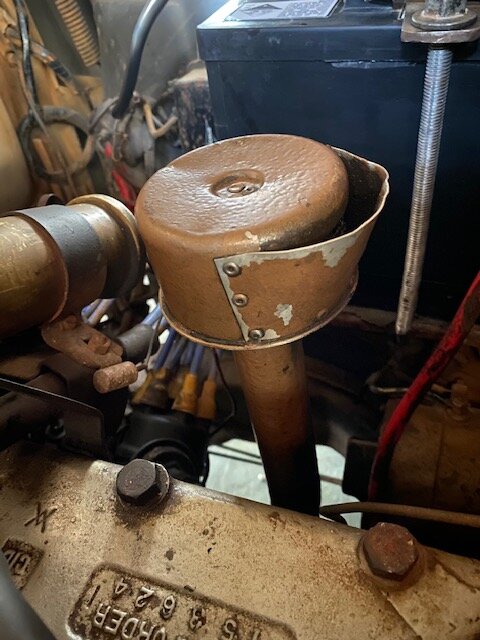
Nigel Bailey
Members-
Posts
50 -
Joined
-
Last visited
-
Days Won
2
Everything posted by Nigel Bailey
-
Hi Chris, not sure: the car previously ran an electric pump and just had a blanking plate over the fuel pump mount. Not a lot of parts availability here in Australia so I get most of my new stuff from Andy Bernbaum or Rock Auto. I'm wanting to return the car to 'standard' looking (although it will be 12V/neg earth) and am also chasing a D6G1 Carter carb to replace the old Stromberg that's on there, but that's another story. It's a steep learning curve for me, but I hope to have the ol' girl back on the road by the end of the year, and the Forum here has been fantastic help. Thanks, Nigel
-
Thanks Young Ed. It's not too late; by the pivot pin, do you mean the shaft that the pump arm rotates on in the pump body? Are you able to send a photo of the solution you suggest? I've also heard that the pins that hold the actual pump arm together can slip out, and that a careful centre punch to flare them out slightly can help, or is this not really an issue? Pump is from Andy Bernbaum.
-
Thanks vey much everyone! Cheers, Nigel
-
Hi all; about to fit a standard mechanical pump (pic attached) to my '48 Dodge D25. A trial fit seems to suggest the pump arm sits under the cam lobe, and on the bench, the arm seems to have a downward stroke of approx. 1/4 inch. I have rotated the motor until the cam is off the lobe next to the pump arm, however there still seems to be some pressure/deflection of the arm when I offer the pump up for fitting. I've never fitted one before: is this normal and am I doing things right? Confirmation or correction from those more experienced/talented than me would be appreciated! Cheers, Nigel
-
Thanks!
-
Hi Chris, I've got the same sort of fuel drain plug fitting on the tank of my 1948 D25 Dodge here in Australia. It looks for all the world to me like a female torx fitting, but surely this can't be right? What do people use to remove the drain plug? Cheers, Nigel
-
Thanks guys-much appreciated! Cheers, Nigel
-
Well, I've got the manifolds off and split without breaking anything (so far)! The plate in my exhaust manifold that directs exhaust gas under the inlet manifold has long since frozen in what looks like the closed position and there are various parts missing. As I live in a warm state in Australia, I was aiming to have this plate closed permanently anyway. My question is, judging by the picture, it almost looks as if some of the plate has been trimmed-shouldn't it close fully against the inside of the exhaust manifold? Or is this the normal closed position? So need to decide whether I should let sleeping dogs lie and leave as is, or weld a new plate in there that fully seals off the space. All suggestions welcome! Thanks, Nigel PS exhaust manifold will be ceramic coated after clean up to (hopefully) reduce heat transfer around the carb/fuel lines/pump.
-
Thanks-I'm pretty sure my Carter carb has a fixed main jet. Good to hear there's another old mopar running around locally. Cheers, Nigel
-
Hi all, my Aussie spec 1948 Dodge D25 (standard Canadian 'long block' 218) is currently running a Stromberg carb, which I'm perfectly happy with, although a Carter BB (pic attached) did come with the car. The Carter is marked as a C6J1, which I believe was late 1930's Plymouth 201, whereas I think mine would have originally been a D6G1. Would a C6J1 work on my car (it is in standard tune, no mods), or should I be looking for a D6G1? Any light thrown on the complex (to me anyway!) world of Carter carbs for my car would be most helpful. I have removed the front panels for better access as I prepare the old girl for life back on the road-I'm right on the limits of my skillset here and appreciate all the great advice on this forum! Cheers, Nigel
-
Thanks so much for taking the time to reply, everyone (and for the diagram Sniper-I get what you mean now)! I'd like to contribute to the Forum with help of my own, but am afraid I'm going to just have to be a sponge for a while while I learn the ropes. Hopefully in the not too distant future there'll be one more old mopar alive and kicking, and back on the road in Australia. Cheers.
-
Thanks Sniper-sorry if this is an obvious question, but how would I go about measuring the departure as you suggested?
-
Thanks; I probably wasn’t clear enough earlier: take-up is not until the last third of an inch, not of overall travel. Clutch does not engage until the pedal is virtually all the way out. Hard to tell, but there is probably a tiny bit of judder on take up. I haven’t driven the car any distance because the brakes are my next job! Sounds like increase the free play a fraction and go from there?
-
Hi all, although the clutch free play on my recently acquired 1948 D25 seems about right, the clutch itself only engages in literally the last 1/3" of travel, ie., when the pedal is almost fully out. I have the correct (Australian) service manual for my car, but it only seems to mention free play adjustment-is there any way of adjusting the clutch engagement point, or does this simply mean the clutch is on the way out? I've never done any work with clutches before and am very new to the world of old Mopars, but I'm keen to learn along the way and (so far) am enjoying the journey! Any advice would be greatly appreciated-no doubt I'll be back on the forum again if it turns out I have to attempt my first clutch replacement! Cheers, Nigel Bailey
-
Thanks all-really appreciate it. Yep sidevalvepete, will be definitely going to Vintage Wiring Harness for the loom-good to hear you're happy with it. Cheers, Nigel
-
Thanks Sam-I believe there are also a number of companies that make ‘generator look’ alternators that have a more traditional style. Certainly minimising the wiring is an attractive proposition. Looks like you’ve got a full flow oil filter there too. Cheers, Nigel
-
Thanks for the help gentlemen! Some great tips there and a few things I wasn’t aware of. There is a vintage lighting specialist out here who does 6 volt LED’s, so more investigation beckons. Still leaning towards a properly maintained 6V/positive earth set up at this stage.
-
Hi all, I am (very) slowly working my way through a 1948 Aussie-spec Dodge D25. It has the original 6 volt electrics, but at some point has been changed to a negative earth/ground. Why anyone would bother to do this, and yet still retain the 6 volt system, is a bit of a mystery to me. I am going to have to replace the original, 72 year old wiring loom at some point, so the decisions I need to make soon are: stay with 6 volt or change to 12 volt? Positive or Negative ground? I have read the 12V conversion link on the site, but am considering retaining the original 6 volt system(albeit with halogen bulb upgrades). If I do so however, it would seem logical to convert back to the original positive ground-so I would like to know what steps are involved in this? As always, I'm keen to hear the thoughts/collective wisdom from the Forum-I've got an open mind on the whole volts/earthing thing. Thanks! Nigel Bailey
-
Ok-I think I've figured it out, thanks to some links on the Forum! I reckon the filler tube has been inserted in the wrong way (180 degrees) around at some point, so that the filler cap opening faces forward instead of back, and a previous owner has simply bodged up a cover over the opening to prevent air being forced down it. I say this because the cap only seems to go on one way-Is this possible? I also can't see any sign of a bracket that might support the top of the tube and attach to the block, but maybe they didn't all have this? I'm assuming the tube is a press fit, and some light taps with a rubber mallet around the base might loosen things up? Advice as always gratefully received by this newbie! Cheers.
-
Thanks for all the replies and advice!-I think I'll remove the piece and the make sure the cap is faced around the right way. Cheers, Nigel
-
Hi all, I have attached a pic of my oil filler breather cap (1948 Aussie Dodge D25), which has a piece of sheet metal pop-riveted to one side. I first thought this was some sort of bodged repair, but it looks like there is a properly formed 'cut out' underneath, through which you can see the gauze of the breather. What's going on here? Should the cap be 'solid' all the way around, or does it have a largish cut-out in one side? Secondly, I have recently acquired this vehicle( conventional 3 speed manual, not Fluid Drive), and the clutch is only taking up in the last inch of the pedal release. I know the manual describes how to adjust pedal free play, but are there any adjustments that can be done to get the clutch to engage earlier? Apologies for any 'obvious' questions here; I'm learning as I go with this car! Thanks, Nigel
-
Thanks Andy-that '41 coupe looks great! No I don't have the original carb, so once the Dodge arrives I'll see what sort of Stromberg is on it, and how it goes. It's still running the original 6 volt system though. Cheers, Nigel
-
Hi all, thanks for the advice. Here are a few photos of the car Andy-so I'd say it's an Oz TJ Richards body then. I'm in Brisbane, but the car is currently in Tasmania; it will be delivered up here in c. 3 weeks' time. It has been fitted with some sort of older Stromberg carb (probably from a Holden) since the mid 70's, so one of the first tasks will be to locate the correct Carter carb! Cheers, Nigel
-
Hi Andy-thanks heaps for the info; I'm coming off a fairly low base with specific knowledge of these cars, so all advice gratefully received! (Didn't know the body was different from US models; just assumed they were assembled in SA from CKD kits). Yes, I do have the Oz specific manual, although it's not as detailed in some places as I'd hoped. Thanks for the offer; at some point I think you'll certainly be receiving a call from me to pick your brains! Cheers, Nigel
-
Hi all, I have just purchased a 1948 Australian-assembled Dodge D25, which I believe is basically a re-badged Plymouth P15, albeit with the 'Canadian' 25" 218 block? My question is: are basic service consumables such as plugs/leads/points/radiator hoses/fan belt etc the same as for the 'American' P15, and will I be right ordering P15 service parts such as these from suppliers in the US? Are there any key differences (apart from the bore and stroke) that I need to be aware of when ordering parts for my D25? This is my first American 'old car' (I have previously run a number of 60's Peugeots and Citroens as daily drivers) and I'm finding your site a fantastic help! Cheers, Nigel






